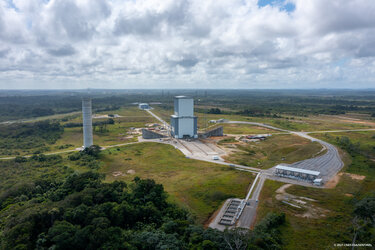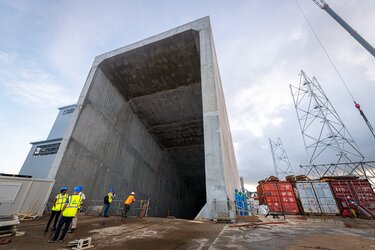

Aerial view of Ariane 5 Launch Zone (ZL3)
Thank you for liking
You have already liked this page, you can only like it once!
It is in this area that, over a period of 6 hours (H0-6h), the final countdown and launch of Ariane 5 are remotely controlled from launch control centre No. 3 (CDL3).
The design of this area is completely new and comprises a minimum number of installations (no mobile ancillary tower, the umbilical tower is completely integral with the launch table).
The following operations take place in the launch zone:
-fuelling of the cryogenic main stage with liquid hydrogen and oxygen, - pressurisation and conditioning operation, and final checks on the cryogenic main stage, - ignition and lift-off.
The design of the Ariane 5 launch zone is simple and comprises a minimum number of fixed installations: - a central platform onto which the launch table is anchored, sided up against the building containing the measurement facilities and the fluid and electrical interfaces, which are connected to the launch table, - a metal tower, which acts as a wind breaker, - 3 stream deflectors (flame deflectors), which are separate and open in order to channel away the flames when the engines are ignited: one for the Vulcain engine stream and one for each solid-propellant booster. A water barrier is triggered inside these flame deflectors in order to attenuate the sound vibration during lift-off, - A water tower, 90 metres high and a reserve of 1500 m3 of water, capable of releasing 30 m3 of water per second during lift-off. This flood of water is also used to cool the launch table and thus protect it from thermal shock and to cool the ducts as well, - 4 lightning conductor masts, which protect the launcher and the installations, a hydrogen gas burn-off pool, connection to the mobile oxygen and hydrogen gas storage installations, connection to the mobile liquid oxygen and hydrogen storage installations.
-
CREDIT
ESA/CNES/Arianespace-S.Corvaja -
LICENCE
ESA Standard Licence

Ariane 6 launch zone

Ariane 6 launch pad water deluge system test

Ariane 6 launch pad under construction

Ariane 6 launch pad under construction

